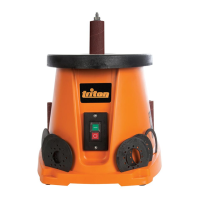6
Oscillating Spindle Sander Safety
WARNING!
• Hold the power tool by insulated handles or gripping surfaces only,
because the sanding belt/sheet may contact its own cord. Cutting a
"live" wire may make exposed metal parts of the power tool ‘live’ and
could give the operator an electric shock.
• Recommendation that the tool always be supplied via a residual
current device with a rated residual current of 30 mA or less.
• If the replacement of the supply cord is necessary, this has to be
done by the manufacturer or his agent in order to avoid a safety
hazard.
The warnings, precautions, and instructions discussed in this manual
cannot cover all possible conditions and situations that may occur. The
operator must understand that common sense and caution are factors which
cannot be built into this product, but must be supplied by the operator.
Do not operate the spindle sander until it is fully assembled and you have
read and understood the following instructions and the warning labels on the
spindle sander.
a) Check the condition of the spindle sander.. If any part is missing, bent,
or does not operate properly, replace the part before using the sander.
b) Determine the type of work you are going to be doing before
operating the spindle sander.
c) Secure your work. Support the workpiece securely on the table, and hold
it with both hands.
d) Be aware of the direction of feed. Feed the workpiece into the sanding
sleeve against the direction of rotation of the sanding sleeve.
e) Always keep your hands out of the path of the sander and away from
the sanding sleeves. Avoid hand positions where a sudden slip could
cause your hand to move into the spindle. Do not reach underneath the
workpiece or around the sanding sleeve while the spindle is rotating.
f) Disconnect the sander after turning off the power switch. Wait for the
spindle to stop rotating before performing maintenance. The sander must
be disconnected when not in use or when changing insert plates, sanding
sleeves, rubber spindles, or other items.
g) Make sure there are no nails or other foreign objects in the area of
the workpiece to be sanded.
h) Never use this sander for wet sanding. Failure to comply may result in
electrical shock, causing serious injury or worse.
i) Use only identical replacement parts when servicing this spindle
sander.
j) Make sure the spindle has come to a complete stop before touching
the workpiece.
k) Take precautions when sanding painted surfaces. Sanding lead-based
paint is NOT RECOMMENDED. The contaminated dust is too difficult to
control, and could cause lead poisoning.
When sanding paint:
a) Protect your lungs. Wear a dust mask or respirator.
b) Do not allow children or pregnant women in the work area until the
paint sanding job is finished and the clean-up is completed
c) Do not eat, drink, or smoke in an area where painted surfaces are
being sanded
d) Use a dust collection system when possible. Seal the work area with
plastic. Do not track paint dust outside of the work area
e) Thoroughly clean the area when the paint sanding project is
completed
Product Familiarisation
1. On/Off Switch
2. Motor Housing
3. Table Top
4. Spindle
5. Table Insert (x6)
6. Rubber Drum (x5)
7. Sanding Sleeve (x6)
8. On-Board Table Insert Storage
9. On-Board Spindle Storage
10. (Rubber drums and sleeves)
11. Dust Port
12. Dust Adaptor (x2)
13. Lower Spindle Washer
14. Upper Spindle Washers (x3)
a.Small
b.Medium
c.Large
15. Wrench
16. Spindle Lock Nut
Intended Use
Bench-mounted sanding machine with a rotating and oscillating sanding drum,
for sanding and shaping of irregular shapes on intricate as well as larger
workpieces
Unpacking Your Tool
• Carefully unpack and inspect your new sander. Familiarise yourself with all its
features and functions
• Ensure that all parts of the tool are present and in good condition. If any parts
are missing or damaged, have such parts replaced before attempting to use
this tool
Before Use
WARNING: Ensure the tool is disconnected from the power supply before
attaching or changing any accessories, or making any adjustments.
Bench mounting
If the spindle sander is to be used in a permanent position, it is recommended
that you secure it to a rigid work surface.
• Use the holes in the base of the spindle sander (image A) as a template to
mark and drill four holes in your intended mounting surface (ie. workbench).
Secure the spindle sander into position using large bolts, washers and nuts
(not supplied)
• If the spindle sander is intended to be more portable, fix a board to the base
which can be easily clamped and removed from various mounting surfaces
• If using bolts make sure they are long enough to penetrate the workbench or
board sufficiently for a secure fix
Dust extraction
It is recommended that the spindle sander is used with a dust extraction
system for a cleaner and safer work environment.
2 Dust Adaptors (11) are supplied with the spindle sander, these can be used
with dust extraction systems that utilise a 32mm (1 1⁄4") or 100mm (4")
diameter hose.
1. Fit the appropriate Dust Adaptor (11) to the Dust Port (10) on the back of the
spindle sander
2. Attach the hose from the dust extraction system to the dust adaptor and
ensure it is secure
3. For greatest efficiency, activate the dust extraction system before turning on
the spindle sander
643723_Z1MANPRO1_AUS.indd 6 24/02/2015 16:42

